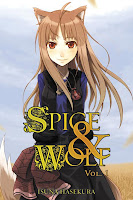 Author: Isuna Hasekura
Author: Isuna Hasekura
Illustrator: Jyuu Ayakura
Translator: Paul Starr
U.S. publisher: Yen Press
ISBN: 9780759531079
Released: December 2010
Original release: 2006
I have been pleasantly surprised by Isuna Hasekura’s Spice & Wolf light novel series. I read the first two books and enjoyed them much more than I expected I would, so it made sense for me to continue with the series and pick up the third volume. Spice & Wolf, Volume 3 was initially published in Japan in 2006 before being released in English by Yen Press in 2010. Once again, Paul Starr has provided the novel’s translation and the original illustrations by Jyuu Ayakura, including several color pages, have been retained. Although I wasn’t blown away by the first two books I did become quite fond of the two main characters, Lawrence and Holo, and their developing relationship. Even the economic theories that play such an important role in the books haven’t managed to scare me off; I was genuinely looking forward to reading the third volume.
After narrowly escaping bankruptcy in Ruvenheigen, Lawrence turns his attention to fulfilling his contract with Holo, the wolf and harvest goddess travelling with him in human form. He has promised Holo to accompany her to her homeland of Yoitsu. Lawrence has heard stories that suggest the place has been destroyed, but he hasn’t been able to bring himself to tell Holo that yet. Heading north, the general direction in which Yoitsu lies, the two of them stop in Kumersun in order to take in the winter festival and allow Lawrence the opportunity to research Yoitsu further. He hopes to narrow down its actual location and to discover evidence against its destruction. Unfortunately, finding Yoitsu is not the only thing he has to worry about—a precocious young merchant has fallen in love at first sight with Holo and will do all that he can to win her affection, even if that means ruining Lawrence in the process.
As I have already mentioned, one of my favorite things about the Spice & Wolf light novels is Lawrence and Holo’s relationship with each other. And largely because of that, the third volume is probably my favorite book in the series so far because it focuses on that relationship. I’ve always enjoyed their constant bantering and teasing, but in volume three Lawrence is forced to carefully consider how much Holo has come to mean to him and what his feelings towards her actually are. However, I will admit that it was initially disconcerting to see him refer to her as cargo several times. Ultimately though, taken in context, I decided this was more endearing than offensive. Lawrence can be a very awkward man, is easily embarrassed, and is a merchant through and through, meaning the way he expresses himself is not always particularly romantic or even polite. What is important though is that he cares tremendously for Holo and her well-being.
Not surprisingly, economics are still critical to Spice & Wolf even though the third volume tends to focus more on the story’s worldbuilding and Lawrence and Holo’s relationship. Lawrence may not be literally fighting for his life this time around, but he is still obviously under a tremendous amount of stress and strain. The supernatural elements of the story are also still there but this time are downplayed in favor of the more realistic aspects of the world. I’m not sure if it’s because Hasekura’s writing has improved or if it’s because Starr’s translation has gotten better, but I found Spice & Wolf, Volume 3 to be much easier to follow than the previous volumes, both economically and otherwise. Although new readers might miss out on some of the complexities of Holo and Lawrence’s relationship, the series can easily be picked up with the third volume without too much trouble. I very much enjoyed Spice & Wolf, Volume 3 and seeing as the series continues to improve, I’ll definitely be reading the next volume as well.


